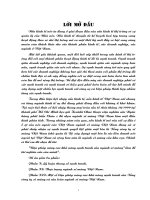DE TAI CloudComputing
Bạn đang xem bản rút gọn của tài liệu. Xem và tải ngay bản đầy đủ của tài liệu tại đây (990.78 KB, 51 trang )
GVHD: TS.TÂN HẠNH
SVTH: ĐÀO ANH VŨ
ĐỀ TÀI MÔN HỌC
2
Outline
Definitions of Cloud computing
Architecture of Cloud computing
Benefits of Cloud computing
Opportunities of Cloud Computing
Cloud computing – Google Apps
Grid computing vs Cloud computing
3
Definitions
4
Definitions
Cloud computing is using the internet to
access someone else's software running
on someone else's hardware in
someone else's data center.
Lewis Cunningham
[2]
5
Definitions
A large-scale distributed computing
paradigm that is driven by economies of
scale, in which a pool of abstracted,
virtualized, dynamically scalable,
managed computing power, storage,
platforms, and services are delivered on
demand to external customers over the
Internet.
Ian Foster
[9]
6
Definitions
A Cloud is a type of parallel and distributed
system consisting of a collection of
interconnected and virtualised computers
that are dynamically provisioned and
presented as one or more unified
computing resources based on service-
level agreements established through
negotiation between the service provider
and consumers.
Rajkumar Buyya
[10]
7
Outline
Definitions of Cloud computing
Architecture of Cloud computing
Benefits of Cloud computing
Opportunities of Cloud Computing
Cloud computing – Google Apps
Grid computing vs Cloud computing
8
Architecture
Cloud Service Models
Cloud Deployment Models
Essential Characteristics of Cloud
Computing
9
Architecture
NIST Visual Model of Cloud Computing Definition
10
Essential Characteristics
[7]
On-demand self-service.
A consumer can unilaterally provision
computing capabilities such as server time
and network storage as needed
automatically, without requiring human
interaction with a service provider.
11
Essential Characteristics
[7]
Broad network access.
Capabilities are available over the network and
accessed through standard mechanisms that
promote use by heterogeneous thin or thick
client platforms (e.g., mobile phones, laptops,
and PDAs) as well as other traditional or
cloudbased software services.
12
Essential Characteristics
[7]
Resource pooling.
The provider’s computing resources are
pooled to serve multiple consumers using a
multi-tenant model, with different physical
and virtual resources dynamically assigned
and reassigned according to consumer
demand.
13
Essential Characteristics
[7]
Rapid elasticity.
Capabilities can be rapidly and elastically
provisioned - in some cases automatically - to
quickly scale out; and rapidly released to
quickly scale in.
To the consumer, the capabilities available for
provisioning often appear to be unlimited and
can be purchased in any quantity at any time.
14
Essential Characteristics
[7]
Measured service.
Cloud systems automatically control and
optimize resource usage by leveraging a
metering capability at some level of
abstraction appropriate to the type of service.
Resource usage can be monitored, controlled,
and reported - providing transparency for both
the provider and consumer of the service.
15
Cloud Service Models
SPI Model
Cloud Software as a Service (SaaS)
Cloud Platform as a Service (PaaS)
Cloud Infrastructure as a Service (IaaS)
16
Infrastructure as a Service (IaaS)
The capability provided to the consumer is to
provision processing, storage, networks, and
other fundamental computing resources.
Consumer is able to deploy and run arbitrary
software, which can include operating systems
and applications.
The consumer does not manage or control the
underlying cloud infrastructure but has control
over operating systems, storage, deployed
applications, and possibly limited control of
select networking components (e.g., host
firewalls).
17
Platform as a Service (PaaS)
The capability provided to the consumer is to
deploy onto the cloud infrastructure consumer
created or acquired applications created using
programming languages and tools supported by
the provider.
The consumer does not manage or control the
underlying cloud infrastructure including network,
servers, operating systems, or storage, but has
control over the deployed applications and
possibly application hosting environment
configurations.
18
Software as a Service (SaaS)
The capability provided to the consumer is to use
the provider’s applications running on a cloud
infrastructure.
The applications are accessible from various
client devices through a thin client interface such
as a web browser (e.g., web-based email).
The consumer does not manage or control the
underlying cloud infrastructure including network,
servers, operating systems, storage, or even
individual application capabilities, with the
possible exception of limited userspecific
application configuration settings.
19
Cloud Deployment Models
Public Cloud.
Private Cloud.
Community Cloud.
Hybrid Cloud.
20
Public Cloud
The cloud infrastructure is made
available to the general public or a large
industry group and is owned by an
organization selling cloud services.
21
Private Cloud
The cloud infrastructure is operated
solely for a single organization. It may be
managed by the organization or a third
party, and may exist on-premises or off-
premises.
22
Community Cloud
The cloud infrastructure is shared by
several organizations and supports a
specific community that has shared
concerns (e.g., mission, security
requirements, policy, or compliance
considerations). It may be managed by
the organizations or a third party and
may exist on-premises or off-premises.
23
Hybrid Cloud
The cloud infrastructure is a composition
of two or more clouds (private,
community, or public) that remain unique
entities but are bound together by
standardized or proprietary technology
that enables data and application
portability (e.g., cloud bursting for load-
balancing between clouds).
24
Private VS Public Cloud
25
Outline
Definitions of Cloud computing
Architecture of Cloud computing
Benefits of Cloud computing
Opportunities of Cloud Computing
Cloud computing – Google Apps
Grid computing vs Cloud computing








